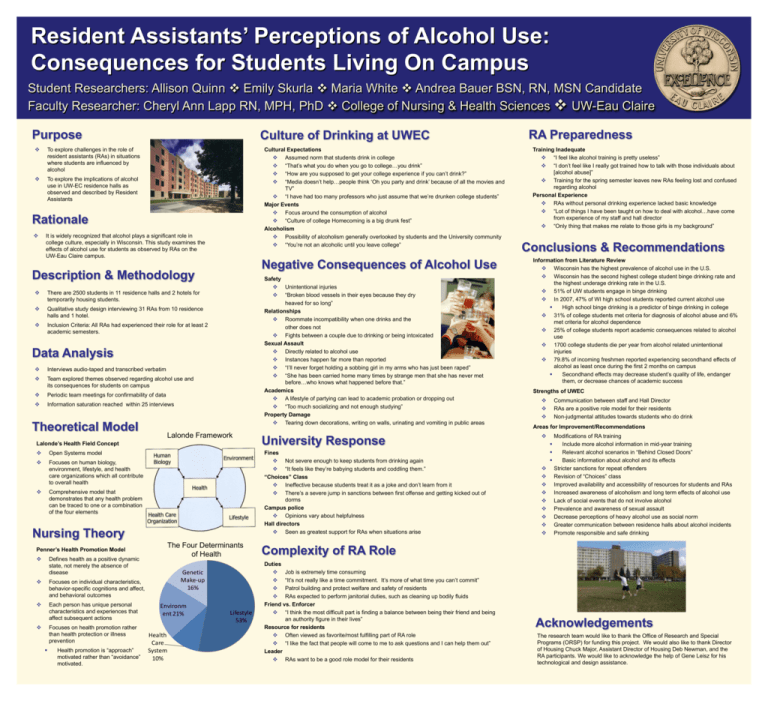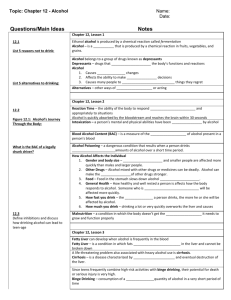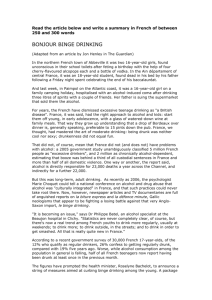QuinnSpr10
advertisement

Resident Assistants’ Perceptions of Alcohol Use: Consequences for Students Living On Campus Student Researchers: Allison Quinn Emily Skurla Maria White Andrea Bauer BSN, RN, MSN Candidate Faculty Researcher: Cheryl Ann Lapp RN, MPH, PhD College of Nursing & Health Sciences UW-Eau Claire Purpose To explore challenges in the role of resident assistants (RAs) in situations where students are influenced by alcohol To explore the implications of alcohol use in UW-EC residence halls as observed and described by Resident Assistants Culture of Drinking at UWEC Cultural Expectations Assumed norm that students drink in college “That’s what you do when you go to college…you drink” “How are you supposed to get your college experience if you can’t drink?” “Media doesn’t help…people think ‘Oh you party and drink’ because of all the movies and TV” “I have had too many professors who just assume that we’re drunken college students” Major Events Focus around the consumption of alcohol “Culture of college Homecoming is a big drunk fest” Alcoholism Possibility of alcoholism generally overlooked by students and the University community “You’re not an alcoholic until you leave college” Rationale It is widely recognized that alcohol plays a significant role in college culture, especially in Wisconsin. This study examines the effects of alcohol use for students as observed by RAs on the UW-Eau Claire campus. Negative Consequences of Alcohol Use Description & Methodology There are 2500 students in 11 residence halls and 2 hotels for temporarily housing students. Qualitative study design interviewing 31 RAs from 10 residence halls and 1 hotel. Inclusion Criteria: All RAs had experienced their role for at least 2 academic semesters. Safety Unintentional injuries “Broken blood vessels in their eyes because they dry heaved for so long” Relationships Roommate incompatibility when one drinks and the other does not Fights between a couple due to drinking or being intoxicated Sexual Assault Directly related to alcohol use Instances happen far more than reported “I’ll never forget holding a sobbing girl in my arms who has just been raped” “She has been carried home many times by strange men that she has never met before…who knows what happened before that.” Academics A lifestyle of partying can lead to academic probation or dropping out “Too much socializing and not enough studying” Property Damage Tearing down decorations, writing on walls, urinating and vomiting in public areas Data Analysis Interviews audio-taped and transcribed verbatim Team explored themes observed regarding alcohol use and its consequences for students on campus Periodic team meetings for confirmability of data Information saturation reached within 25 interviews Theoretical Model Lalonde Framework Lalonde’s Health Field Concept Open Systems model Focuses on human biology, environment, lifestyle, and health care organizations which all contribute to overall health Comprehensive model that demonstrates that any health problem can be traced to one or a combination of the four elements Fines Not severe enough to keep students from drinking again “It feels like they’re babying students and coddling them.” “Choices” Class Ineffective because students treat it as a joke and don’t learn from it There’s a severe jump in sanctions between first offense and getting kicked out of dorms Campus police Opinions vary about helpfulness Hall directors Seen as greatest support for RAs when situations arise Nursing Theory The Four Determinants of Health Penner’s Health Promotion Model Defines health as a positive dynamic state, not merely the absence of disease Focuses on individual characteristics, behavior-specific cognitions and affect, and behavioral outcomes Each person has unique personal characteristics and experiences that affect subsequent actions Focuses on health promotion rather than health protection or illness prevention Health promotion is “approach” motivated rather than “avoidance” motivated. University Response Genetic Make-up 16% Environm ent 21% Health Care System 10% Lifestyle 53% RA Preparedness Training Inadequate “I feel like alcohol training is pretty useless” “I don’t feel like I really got trained how to talk with those individuals about [alcohol abuse]” Training for the spring semester leaves new RAs feeling lost and confused regarding alcohol Personal Experience RAs without personal drinking experience lacked basic knowledge “Lot of things I have been taught on how to deal with alcohol…have come from experience of my staff and hall director “Only thing that makes me relate to those girls is my background” Conclusions & Recommendations Information from Literature Review Wisconsin has the highest prevalence of alcohol use in the U.S. Wisconsin has the second highest college student binge drinking rate and the highest underage drinking rate in the U.S. 51% of UW students engage in binge drinking In 2007, 47% of WI high school students reported current alcohol use High school binge drinking is a predictor of binge drinking in college 31% of college students met criteria for diagnosis of alcohol abuse and 6% met criteria for alcohol dependence 25% of college students report academic consequences related to alcohol use 1700 college students die per year from alcohol related unintentional injuries 79.8% of incoming freshmen reported experiencing secondhand effects of alcohol as least once during the first 2 months on campus Secondhand effects may decrease student’s quality of life, endanger them, or decrease chances of academic success Strengths of UWEC Communication between staff and Hall Director RAs are a positive role model for their residents Non-judgmental attitudes towards students who do drink Areas for Improvement/Recommendations Modifications of RA training Include more alcohol information in mid-year training Relevant alcohol scenarios in “Behind Closed Doors” Basic information about alcohol and its effects Stricter sanctions for repeat offenders Revision of “Choices” class Improved availability and accessibility of resources for students and RAs Increased awareness of alcoholism and long term effects of alcohol use Lack of social events that do not involve alcohol Prevalence and awareness of sexual assault Decrease perceptions of heavy alcohol use as social norm Greater communication between residence halls about alcohol incidents Promote responsible and safe drinking Complexity of RA Role Duties Job is extremely time consuming “It’s not really like a time commitment. It’s more of what time you can’t commit” Patrol building and protect welfare and safety of residents RAs expected to perform janitorial duties, such as cleaning up bodily fluids Friend vs. Enforcer “I think the most difficult part is finding a balance between being their friend and being an authority figure in their lives” Resource for residents Often viewed as favorite/most fulfilling part of RA role “I like the fact that people will come to me to ask questions and I can help them out” Leader RAs want to be a good role model for their residents Acknowledgements The research team would like to thank the Office of Research and Special Programs (ORSP) for funding this project. We would also like to thank Director of Housing Chuck Major, Assistant Director of Housing Deb Newman, and the RA participants. We would like to acknowledge the help of Gene Leisz for his technological and design assistance.





